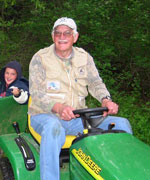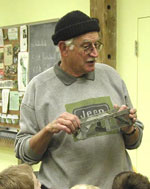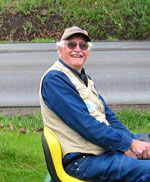Posted on Friday, September 8, 2006
In the next months I will be writing to familiarize the Globe-Leader readers with what is happening at the Field Station operated by Westminster College. These will be short and sweet. They will take on a very personal and folksy flavor. Technical jargon will be limited. There will be some pictures to convince the readers that the Field Station exists and is used by the college and the community.
The usual terminology that sometimes is bantered about in academic circles could be confusing to those who do not regularly bother with the precise meaning of words. "Field Station" could be thought of as a farm with different parts or stations. Or, perhaps, an open field with some buildings stationed on it. As generally used, however, a Field Station is a special outdoor place devoted to environmental education and research. Places like these are most often associated with colleges and universities and, within those institutions, the departments of biology and environmental science frequently get the challenge of operating the facilities.
How many such field stations exist? The number is huge, especially if international settings are included. In the United States, The International Organization of Biological Field Stations lists 78 and another group, The Organization of Biological Field Stations, lists more than 200. Neither of these listings, however, is complete. Westminster's Field Station is not included in either list, primarily because the paperwork just hasn't been done. We do qualify. We have a Field Station!
The nearest Field Station listed by both of the above groups is The Pymatuning Laboratory of Ecology operated by the University of Pittsburgh's Department of Biological Sciences on the shores of the Pymatuning Reservoir. The Pymatuning area lies within the glaciated portion of Pennsylvania and is characterized by a diversity of habitat types reflecting the intermingling of three major forest types and the abundant lakes, streams and wetlands of the area. The laboratory and teaching facilities are located within an 11,000-acre Wildlife Sanctuary and Propagation area owned by the Commonwealth of Pennsylvania. The facilities are primarily for education and research. They are open to the public on a limited basis.
Westminster's Field Station is a 50-acre plot that extends east from Brittain Lake on the main campus to the Fayette-New Wilmington Road. And, an important note, this is only one part of the Outdoor Laboratory for Biological and Environmental Sciences. The other parts are Brittain Lake, approximately 15 acres, and the College Woods near Route 158 south of New Wilmington, approximately 40 acres. These three facilities have an integrating theme: education in the out-of-doors. All are multi-use places. This means that the public, and especially children, are invited to come and benefit from these laboratories in the world of nature.
At the Field Station we have a classic "Pennsylvania bank barn," built with two levels in 1877 by William Cox. Twelve years ago we restored this charming old barn and converted it into a useful Nature Center. Hand-hewn beams are exposed and add character to the building. Here we have several separate rooms and labs, a bathroom and an office. We are handicapped accessible. The Nature Center is used year 'round.
We do have research projects at the Field Station but our main passion is people. Every student in an introductory biology or environmental science class spends time here. Several chemistry classes use the facility. Cub Scouts regularly meet here. Children from the ranks of the college's preschool, Wilmington first grade and Lawrence County Head Start school make their way here at least once a year. Community service clubs are welcome. A "laboratory" - indoors or outdoors - is where there is action and hands-on participation. As one of my professors once told me, "a laboratory is where there is a lot of LABOR and minimal ORATORY."
Keep reading these columns for more details on how the environment of the Field Station is being studied, used, enjoyed and, of course, preserved. We are committed to these tasks and to environmental education at all levels.
Clarence Harms, Director of the Field Station


